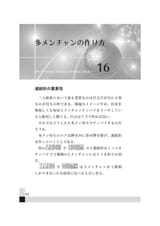Search Results
6/26/2025, 4:08:53 PM
>Chapter 16
>How to get many-sided waits
>The importance of sequential shapes
>While the most important thing in sanma is hand value, the second most important thing is a good wait. As an extreme example, if you ignored your opponents and called riichi with a sanmenchan every single hand, you'd be unbeatable. You could always get your value from dora.
>So how do we get these many-sided waits?
>The trick to getting them is in making connected groups by joining tiles with inner tiles.
TN: This is the stupidest sentence I typed for this TL so far.
>Sequential shapes like 3456s or 4567s are especially good. From a sticky iishanten they can each draw two kinds of tiles to make a sanmenchan wait.
>Shapes closer to the outside like 2345s are a bit worse as they can only draw one kind of tile to get a sanmenchan.
>When these shapes include terminals, e.g. 6789s, they cannot develop into a sanmenchan and are therefore the worst of these shapes when you are in sticky iishanten. (However, keep in mind that they can function as a nobetan wait when you don't have a pair.)
>Nakabukure shapes like 3445s are valuable because they can easily become one sequence and one ryanmen, but they cannot make sanmenchan and are thus worse than the four consecutive tiles shapes.
>To make these four tile shapes, it's important to connect your tiles to the inside. Tanyao is harder to make in sanma, but the logic of inner tiles being useful is the same as in yonma.
>The next important topic is to use tanki waits.
>If you choose a tanki wait and then connect it to a triplet or sequence, you can get strong multi-sided waits.
>11m24p333456s pon 777z
>This is already tenpai with a kanchan on 3p, but if 1m comes out you should pon it.
>The next time you draw a souzu, you'll get a multi-sided wait. A 7s draw will give you a 24578s wait, a 2s or 4s draw result in a 4-sided wait, etc.
>How to get many-sided waits
>The importance of sequential shapes
>While the most important thing in sanma is hand value, the second most important thing is a good wait. As an extreme example, if you ignored your opponents and called riichi with a sanmenchan every single hand, you'd be unbeatable. You could always get your value from dora.
>So how do we get these many-sided waits?
>The trick to getting them is in making connected groups by joining tiles with inner tiles.
TN: This is the stupidest sentence I typed for this TL so far.
>Sequential shapes like 3456s or 4567s are especially good. From a sticky iishanten they can each draw two kinds of tiles to make a sanmenchan wait.
>Shapes closer to the outside like 2345s are a bit worse as they can only draw one kind of tile to get a sanmenchan.
>When these shapes include terminals, e.g. 6789s, they cannot develop into a sanmenchan and are therefore the worst of these shapes when you are in sticky iishanten. (However, keep in mind that they can function as a nobetan wait when you don't have a pair.)
>Nakabukure shapes like 3445s are valuable because they can easily become one sequence and one ryanmen, but they cannot make sanmenchan and are thus worse than the four consecutive tiles shapes.
>To make these four tile shapes, it's important to connect your tiles to the inside. Tanyao is harder to make in sanma, but the logic of inner tiles being useful is the same as in yonma.
>The next important topic is to use tanki waits.
>If you choose a tanki wait and then connect it to a triplet or sequence, you can get strong multi-sided waits.
>11m24p333456s pon 777z
>This is already tenpai with a kanchan on 3p, but if 1m comes out you should pon it.
>The next time you draw a souzu, you'll get a multi-sided wait. A 7s draw will give you a 24578s wait, a 2s or 4s draw result in a 4-sided wait, etc.
Page 1
